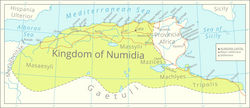
Back Numidië Afrikaans نوميديا Arabic نوميديا ARY Reinu de Numidia AST Numidiya Azerbaijani نومیدیا AZB Нумідыя Byelorussian Нумидия Bulgarian Numidia Breton Numidija BS
Kingdom of Numidia | |||||||||||||||
|---|---|---|---|---|---|---|---|---|---|---|---|---|---|---|---|
| 202 BC–25 BC | |||||||||||||||
|
Numidian coins under Massinissa | |||||||||||||||
 Map of Numidia after the Punic wars | |||||||||||||||
| Capital | Cirta (today Constantine, Algeria) | ||||||||||||||
| Official languages | Punic[a][2][3][4] | ||||||||||||||
| Common languages | Numidian[b] Latin[c] Greek[d] | ||||||||||||||
| Government | Monarchy | ||||||||||||||
| King | |||||||||||||||
• 202–148 BC | Masinissa | ||||||||||||||
• 60–46 BC | Juba I of Numidia | ||||||||||||||
• 30–25 BC | Juba II of Numidia | ||||||||||||||
| Historical era | Antiquity | ||||||||||||||
• Established | 202 BC | ||||||||||||||
• Annexed by the Roman Empire | 25 BC | ||||||||||||||
| |||||||||||||||
| Today part of | |||||||||||||||
| History of Algeria |
|---|
 |
Numidia was the ancient kingdom of the Numidians in northwest Africa, initially comprising the territory that now makes up Algeria, but later expanding across what is today known as Tunisia and Libya. The polity was originally divided between the Massylii in the east and the Masaesyli in the west. During the Second Punic War (218–201 BC), Masinissa, king of the Massylii, defeated Syphax of the Masaesyli to unify Numidia into the first Berber state in present-day Algeria.[10] The kingdom began as a sovereign state and later alternated between being a Roman province and a Roman client state.
Numidia, at its largest extent, was bordered by Mauretania to the west, at the Moulouya River,[11] Africa Proconsularis to the east, the Mediterranean Sea to the north, and the Sahara to the south.
- ^ Quinn, Josephine Crawley; Vella, Nicholas C. (2014-12-04). The Punic Mediterranean. Cambridge University Press. ISBN 978-1-107-05527-8.
- ^ Baldauf, Richard B.; Kaplan, Robert B. (2007-01-01). Language Planning and Policy in Africa. Multilingual Matters. p. 38. ISBN 978-1-84769-011-1.
Numidic kings and elites spoke and used Punic as the official language while peasants spoke Berber. The Carthaginian idiom was in use until the third century CE
- ^ Fage, J. D.; Oliver, Roland Anthony (1975). The Cambridge History of Africa. Cambridge University Press. p. 184. ISBN 978-0-521-21592-3.
Punic was employed as the official language of the Numidian kingdom, as is shown by monumental inscriptions and coin legends. Numidia even became something of a centre of Punic literary culture. In 146 BC the Romans presented to Micipsa the captured library of Carthage, and in the following century, as has been seen, a Numidian king (Hiempsal II) wrote a history of his country in Punic.
- ^ Hoyos, B. Dexter (2015). Mastering the West: Rome and Carthage at War. Oxford University Press. p. 277. ISBN 978-0-19-986010-4.
The Punic language and religion survived the cataclysm too. Many if not most Libyan communities used Punic for official purposes, as did the Numidian kingdom.
- ^ Boutammina, Nas E. (2022-01-06). Le numide, langue populaire de la Berbérie (in French). Books on Demand. ISBN 978-2-322-41710-0.
- ^ Chaker, S. (2008-01-01). "Libyque : écriture et langue". Encyclopédie berbère (in French) (28–29): 4395–4409. doi:10.4000/encyclopedieberbere.344. ISSN 1015-7344. S2CID 161729616.
- ^ Camps, G.; Claudot-Hawad, H.; Chaker, S.; Abrous, D. (1996-08-01). "Écriture". Encyclopédie berbère (in French) (17): 2564–2585. doi:10.4000/encyclopedieberbere.2125. ISSN 1015-7344.
- ^ Hirst, Anthony; Silk, Michael (2017-05-15). Alexandria, Real and Imagined. Routledge. ISBN 978-1-351-95959-9.
- ^ Roller, Duane W. (2004-02-24). The World of Juba II and Kleopatra Selene: Royal Scholarship on Rome's African Frontier. Routledge. ISBN 978-1-134-40296-0.
- ^ Thomas M. Leonard (2013). Encyclopedia of the Developing World. Routledge. p. 169. ISBN 978-1-135-20508-9.
- ^ Dictionary of Greek and Roman Geography. Retrieved 16 February 2020.
Cite error: There are <ref group=lower-alpha> tags or {{efn}} templates on this page, but the references will not show without a {{reflist|group=lower-alpha}} template or {{notelist}} template (see the help page).
© MMXXIII Rich X Search. We shall prevail. All rights reserved. Rich X Search
